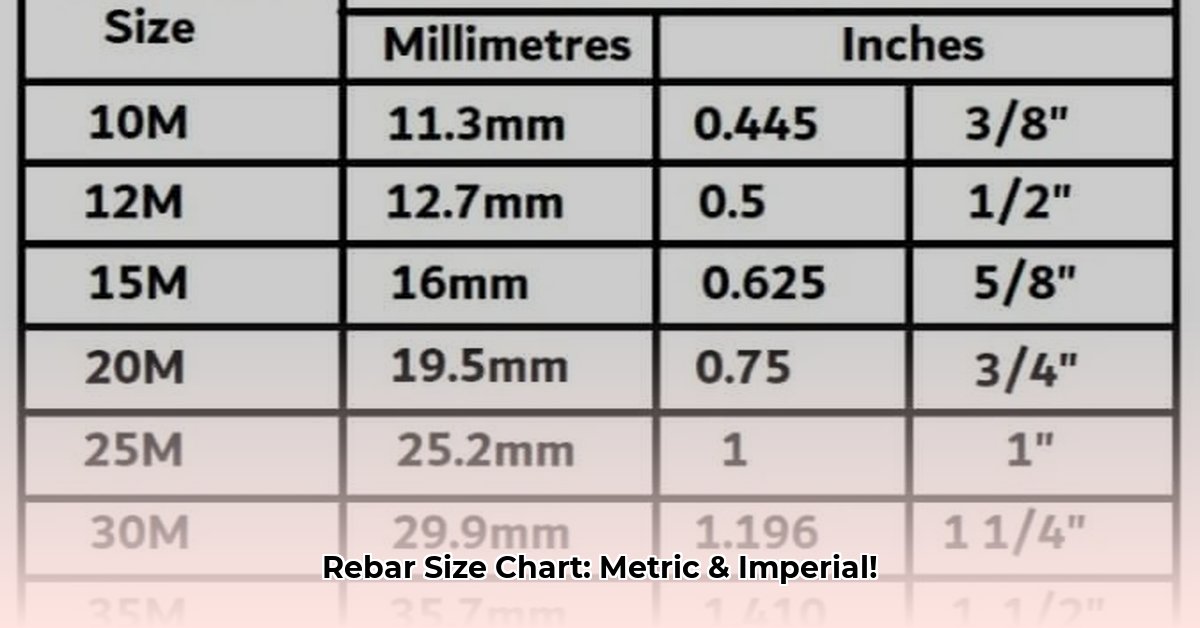Understanding Rebar
Reinforced concrete, a composite material combining the compressive strength of concrete with the tensile strength of steel reinforcing bars (rebar), is ubiquitous in construction. Concrete, while strong under compression, is inherently weak under tension. Rebar, embedded within the concrete, compensates for this weakness, enabling the composite material to withstand a wider range of stresses without cracking or failure. This guide provides a comprehensive overview of rebar sizes, including US customary and metric units, along with practical guidance on using rebar size charts.
Rebar Size Charts
Clear and accurate size charts are essential for quickly determining the right rebar for any project. The following tables provide key dimensional data for both US customary and metric rebar. A downloadable PDF version of these charts may prove beneficial for on-site use.
US Customary Rebar Sizes
| Bar Size | Diameter (in) | Diameter (mm) | Area (in²) | Area (mm²) | Weight (lb/ft) | Weight (kg/m) |
|---|---|---|---|---|---|---|
| #2 | 0.250 | 6.35 | 0.05 | 32 | 0.167 | 0.249 |
| #3 | 0.375 | 9.53 | 0.11 | 71 | 0.376 | 0.561 |
| #4 | 0.500 | 12.7 | 0.20 | 129 | 0.668 | 0.996 |
| #5 | 0.625 | 15.88 | 0.31 | 200 | 1.043 | 1.556 |
| #6 | 0.750 | 19.05 | 0.44 | 284 | 1.502 | 2.24 |
| #7 | 0.875 | 22.23 | 0.60 | 387 | 2.044 | 3.049 |
| #8 | 1.000 | 25.4 | 0.79 | 509 | 2.670 | 3.982 |
| #9 | 1.128 | 28.65 | 1.00 | 645 | 3.400 | 5.071 |
| #10 | 1.270 | 32.26 | 1.27 | 819 | 4.303 | 6.418 |
| #11 | 1.410 | 35.81 | 1.56 | 1006 | 5.313 | 7.924 |
| #14 | 1.693 | 43.0 | 2.25 | 1452 | 7.650 | 11.41 |
| #18 | 2.257 | 57.3 | 4.00 | 2581 | 13.60 | 20.284 |
Metric Rebar Sizes
| Bar Size (mm) | Area (mm²) | Weight (kg/m) |
|---|---|---|
| 6 | 28.3 | 0.222 |
| 8 | 50.3 | 0.395 |
| 10 | 78.5 | 0.617 |
| 12 | 113 | 0.888 |
| 16 | 201 | 1.579 |
| 20 | 314 | 2.467 |
| 25 | 491 | 3.855 |
| 32 | 804 | 6.316 |
| 40 | 1257 | 9.868 |
| 50 | 1963 | 15.413 |
Decoding Rebar Sizing Systems
US Customary
In the US, rebar is designated by a number preceded by a “#”. This number approximately corresponds to the bar’s diameter in eighths of an inch. For example, a #4 rebar has a nominal diameter of 4/8 inch or 1/2 inch. It’s important to distinguish between nominal diameter and actual diameter. The nominal diameter is a standardized designation, while the actual diameter might vary slightly due to manufacturing tolerances. Similarly, nominal area refers to the theoretical cross-sectional area based on the nominal diameter.
Metric
Metric rebar sizing is more straightforward. The number directly corresponds to the nominal diameter in millimeters. Thus, a 20mm rebar has a nominal diameter of 20 millimeters.
Using the Rebar Size Chart
To calculate the total weight of rebar needed, simply identify the rebar size on the chart, note the weight per unit length, and multiply by the required length.
Example: Calculate the weight of 20 feet of #4 rebar.
- Locate #4 rebar on the US customary chart.
- The weight per foot is listed as 0.668 lb/ft.
- Multiply: 0.668 lb/ft * 20 ft = 13.36 lb.
- Therefore, 20 feet of #4 rebar weighs approximately 13.36 pounds.
The chart can also be used to compare different rebar sizes, aiding in the selection process based on project needs. For example, one might compare the area of #5 and #6 rebar to assess their respective load-carrying capacities.
Rebar Grades and Types
Rebar is available in various grades, which indicate the yield strength of the steel. Common grades include Grade 40, Grade 60, and Grade 75. Higher grade numbers correspond to increased yield strengths.
Different rebar types are also available, designed for specific applications. Epoxy-coated rebar, for example, provides enhanced corrosion resistance in harsh environments. Other specialized types include stainless steel rebar and galvanized rebar.
Applications of Different Rebar Sizes
Different rebar sizes are appropriate for different structural applications. Smaller bars, such as #3 and #4, are often used in slabs and light-duty walls. Medium-sized bars, like #5 and #6, are common in walls and smaller beams. Larger sizes, such as #7 and above, are typically used in columns, larger beams, and other elements requiring higher load-bearing capacity. The American Concrete Institute (ACI) provides detailed guidelines on rebar selection and placement, including minimum spacing requirements and concrete cover. Factors such as the intended use of the structure, expected loads, and environmental conditions influence the selection of rebar size and type.
Frequently Asked Questions (FAQ)
- What is the difference between deformed and plain rebar? Deformed rebar has surface ribs or lugs that enhance its bond with the concrete, while plain rebar has a smooth surface. Deformed rebar is more commonly used in structural applications.
- How do I calculate the length of rebar needed for a project? The required rebar length depends on the specific design of the reinforced concrete element. Structural drawings typically specify the length, spacing, and placement of rebar within the concrete.
- What are the standard lengths of rebar available? Rebar is typically available in standard lengths of 20 feet and 40 feet. Custom lengths may also be available upon request. However, due to transportation and handling constraints, excessively long bars may be impractical.
- How do I store rebar to prevent corrosion? Rebar should be stored off the ground in a dry, well-ventilated area. Covering the rebar with a tarp or other protective material can help shield it from moisture.
- What is the density of steel used for calculating rebar weight? The density of steel commonly used in rebar calculations is approximately 7850 kg/m³ or 490 lb/ft³. This value can differ slightly based on the specific alloy composition.
Conclusion
Selecting the correct rebar size is critical for the structural integrity and safety of reinforced concrete constructions. Understanding the various sizing systems, grades, types, and applications of rebar is essential for making informed decisions. Using the provided rebar size charts, along with the explanations and examples included in this guide, will help ensure that the appropriate rebar is chosen for any project. While this guide aims to be comprehensive, consulting with structural engineers or referring to industry standards such as those published by the ACI and ASTM is always recommended, especially for complex structural projects. Continuous advancements in material science and engineering suggest that rebar technology and practices will continue to evolve, making ongoing learning and adaptation crucial in construction.
- Hydro Extrusions USA Leads North American Aluminum Profile Solutions - December 28, 2025
- Hydro North America Leads Aluminum Extrusion Solutions Across Diverse Industries - December 27, 2025
- Hydro Extrusion North America Provides Custom Solutions Across Diverse - December 26, 2025
















